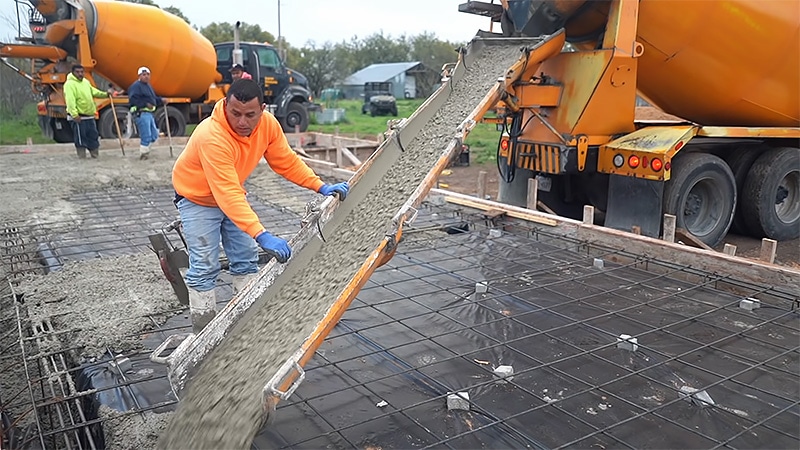Yes, you should always seal concrete before painting it. This is pretty easy to do, as long as you have a good-quality primer. It’s an essential step of the painting process that shouldn’t be overlooked.
The primer is used to fill small gaps, cracks, or voids to create a smooth and uniform finish. It works as a bonding agent between the concrete and the paint, ensuring proper adhesion. The primer will soak straight into the cement, which protects it from damage over time. This can ultimately increase the lifespan of your painted concrete.
If the concrete you plan to paint is unpainted, peeling, chipping, chalking, or cracking, it must be sealed with a good primer.
There are a few different varieties of primers to choose from. Acrylic or latex primer is the most popular choice, as it is more likely to soak into the concrete than an oil-based primer. Some people prefer to seal concrete with epoxy, which is incredibly strong and durable. However, this is a little more difficult to work with than the acrylic or latex kind.

What Should I Use to Clean Concrete Before Painting?
- You should begin cleaning the concrete surface by removing any dirt or debris.
- Then, scrub away any stubborn grime or existing paint flakes using a scraper tool and a wire brush. Don’t tire yourself trying to scrub away stains, as these will be covered later.
- Remove any weeds or plant life from between the cracks if you plan to paint a concrete floor outdoors.
- If your concrete surface has oil or grease staining, you can remove it using tri-sodium phosphate (TSP). You can find it at most DIY stores, which involves mixing it with water. The ratio can vary from brand to brand, so always check the label before pouring it onto your concrete surface. Rinse it off once the stains have disappeared, and allow the surface to dry completely before applying primer or paint.
Does Concrete Absorb Paint?
Yes, concrete can absorb paint. However, you shouldn’t allow this to happen. Concrete is extremely absorbent and porous, so it will “drink” pretty much any liquid it comes in contact with. If you paint straight onto concrete without priming, you’ll end up using a lot more paint than you initially planned. Air bubbles will rise to the paint's surface as the paint fills the tiny holes and cracks. These can potentially ruin thpaint’shed result.
Use a good-quality primer to prevent pesky air bubbles from destroying your concrete makeover. This will ensure that all holes in the concrete are filled and specially designed to minimize the number of air bubbles.
It’s also important to remember that if concreIt’san absorb paint and primer, it can also absorb water. Moisture can greatly affect the final result and hinder the entire process. Even if the surface may appear dry, rainwater may be hiding beneath the cracks on the rough surface. Ensure that your concrete surface is completely dry before priming and painting.

Does Painting Concrete Seal It?
No, painting concrete doesn’t seal it. Not completely. Using a sealadoesn’trimer is important to ensure moisture can’t get trapped inside.
Suppose you plan to can’t an area that experiences heavy foot or vehicle traffic or has a lot of furniture. In that case, you’ll definitely need a concrete sealant to pyou’ll the paint from peeling, flaking, wearing off, or getting scratched. You can get concrete sealant in both matte and glossy finishes, allowing you the choice of adding a smooth or shiny surface.
For particularly rough concrete with deep cracks, you may even want to consider applying two coats of concrete sealant. A second coat can help to level out any uneven patches and provide your concrete with an added layer of protection. However, if the area you plan to paint doesn’t experience much foot or vehicle traffidoesn’t a second coat probably won’t be necessary. Regardless, you’ll still nwon’tt least one coat before paiyou’ll as painting concrete does not seal it.
👉 Don't miss:
How Do I Bond Paint to Concrete?
You can bond paint to concrete by using a bonding primer. When applied to concrete before painting, these serve two main purposes— they seal the concrete surface and develop a bond line for a coating or topping to bond to the substrate.
Bonding primer guarantees that your concrete paint will stand the test of time and adhere firmly to the surface. To ensure the best bonding possible, consider using either epoxy, polyurethane, or acrylic paints. These are far more durable than oil, or alkyd paints on concrete.
If you plan on using water-resistant paint, clean and roughen the surface using sandpaper. Scrub the floor with TSP or a strong detergent before painting. The paint is far less likely to bond to the concrete if it is contaminated with oil or grease.
Want to know how you can Paint Over Adhesive Residue? Click here to read it.
Should I PVA the Garage Floor Before Painting?
While professionals don’t recommend using PVA as a sealant before don’ting, some people have succeeded. If you can afford to get your hands on a good quality primer recommended by the floor paint manufacturer you are going to use, you definitely should. If you use the wrong type of primer or PVA, you risk lifting and peeling paint, which is difficult to remove without starting from scratch.
There is some debate about whether sealing a concrete floor with PVA is a good idea. It’s true that any splashes that go outside thIt’soor, such as on the walls, will be problematic when applying emulsion paint or that the sealer will go tacky and sticky when applying adhesive. You can find PVA at your local hardware store or DIY store.





